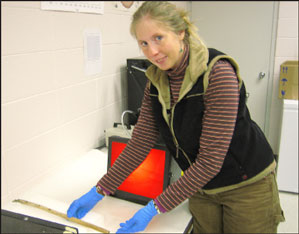Range Creek flute
The age of a prehistoric flute found three years ago in Range Creek area will be determined by Dr. Tammy Rittenour, director of the Utah State University Luminescence Laboratory.
Rittenour was at the College of Eastern Utah’s Prehistoric Museum March 2 to extract a tiny tin of sand grains from the prehistoric flute found near Range Creek in 2006. She will date the sand using a new technique called Optically Stimulated Luminescence to determine if the flute is a few hundred, thousand, or several thousand years old.

This archived article was written by: Renee Barlow
The age of a prehistoric flute found three years ago in Range Creek area will be determined by Dr. Tammy Rittenour, director of the Utah State University Luminescence Laboratory.
Rittenour was at the College of Eastern Utah’s Prehistoric Museum March 2 to extract a tiny tin of sand grains from the prehistoric flute found near Range Creek in 2006. She will date the sand using a new technique called Optically Stimulated Luminescence to determine if the flute is a few hundred, thousand, or several thousand years old.
In August 2008, representatives of the Hopi, including Leigh Kuwanwisiwma and six tribal elders, visited the museum to examine the flute and other artifacts and exhibits in the museum. They consulted with museum staff about research of the flute, specifically how to determine its age.
They discussed the pros and cons of radiocarbon dating versus luminescence, and decided on the latter since it is not destructive. Hopi tribal representatives and Ute Elder Clifford Duncan continue to consult and collaborate with CEU personnel as they work to discover which culture made this unique artifact, and how and why it was deposited in Eastern Utah so long ago.
The flute was discovered by Utah Division of Wildlife officer Alan Green while he was patrolling Range Creek in 2006. The site was blessed by Ute tribal Elder Duncan and documented by archaeologist Jodie Patterson, accompanied by DWR and CEU Prehistoric Museum personnel.
The flute is one-of-a-kind, and is likely the most significant find in this region since the famous Pilling Figurines were discovered by cowboy Clarence Pilling in 1950. It is the only flute found “in situ” (situated in the original, natural or existing place or position) in this region, and may be the first documented Fremont flute.
In some traditional Native American cultures, flutes are associated with courting behavior. Sometimes men would play a flute and bring gifts long distances to woo potential brides. The longer the flute, and the lower the tones it could make, the more attractive the marriage offer. The Range Creek flute is nearly 80 centimeters long.




